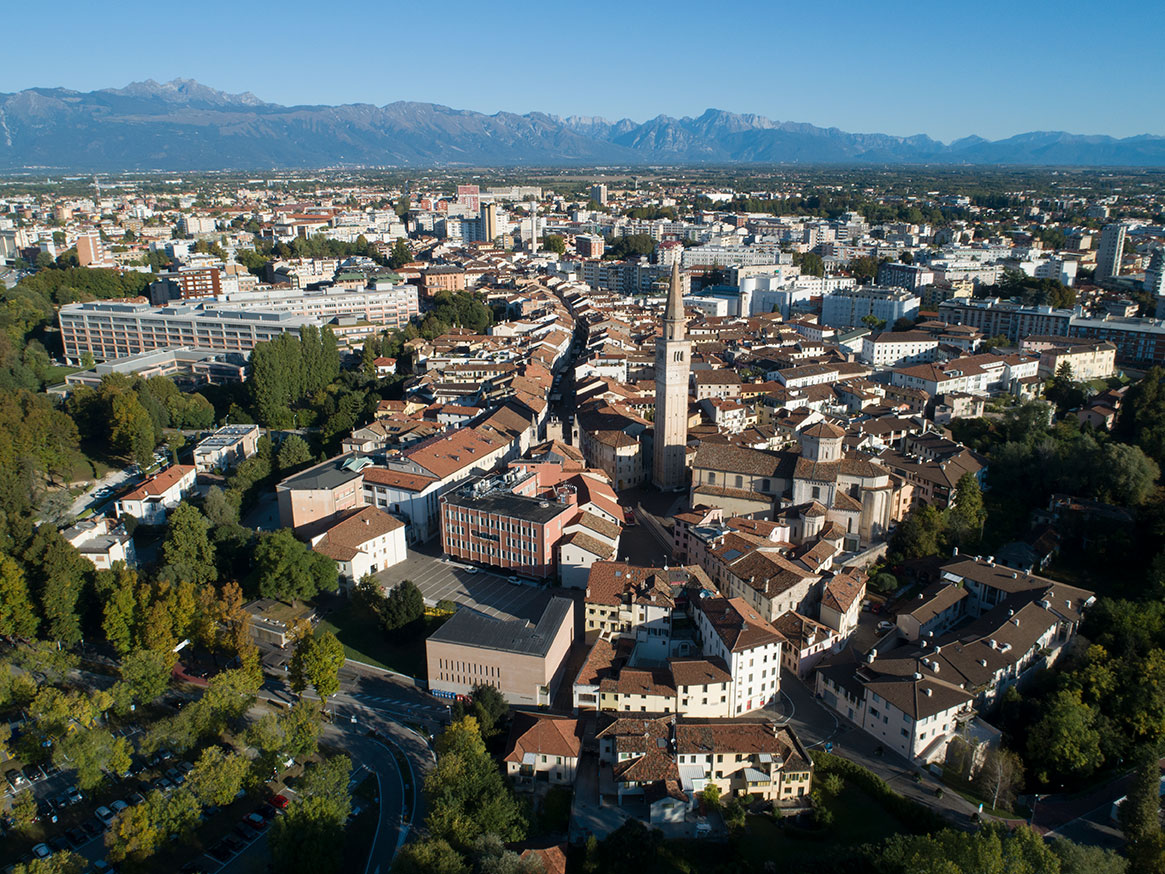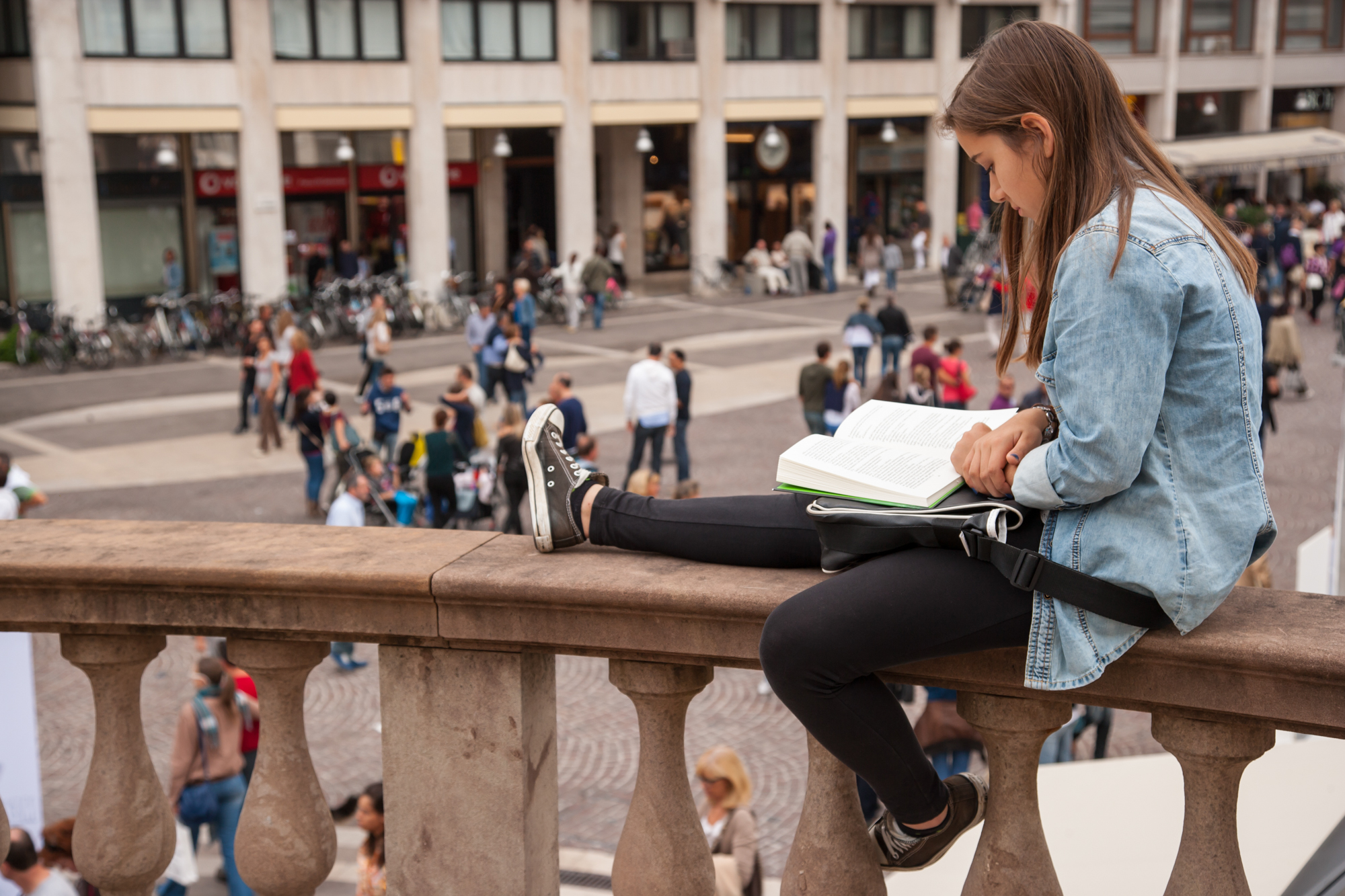
Credits Comune di Pordenone
Founded on the banks of the River Noncello, the history of Pordenone (the ancient Portus Naonis) is inextricably linked to that of the waterway, which made it an important hub of the Roman Empire and later as part of the Republic of Venice.
Like many other nearby cities and villages, the influence of La Serenissma (as the Venetian Republic was called) is still visible in the Venetian-style palaces and arcaded walkways that make up the heart of the old town.
Today, Pordenone is a delightful city enlivened by numerous cultural initiatives and events just waiting to be discovered.
How to reach Pordenone from Lignano Sabbiadoro
By car

Take state road S.R. 354 towards Latisana. Just before reaching Paludo, turn left on Via Mauro and continue down the road that runs along the banks of the River Tagliamento until you reach the traffic signal. Turn left to take SS14 heading towards Portogruaro. Take the exit for S.R. 251. Continue on until the entrance to the A28 motorway, taking it until Pordenone.
Travel time: 50 minutes
8 things to see and do in and around Pordenone

Credits Elio e Stefano Ciol
1. Go for a stroll in the old town
The old town of Pordenone is perfect for a visit in both the warm days of summer and even on cold, rainy days thanks to its many covered walkways. These picturesque arcades make it possible to enjoy the city while protected from the weather, having a look at the numerous boutique windows along Corso Vittorio Emanuele II.
As you shop, you can admire the historical noble buildings that are used today as homes, offices, museums and galleries. Stop for a coffee break in one of the many cafes with outdoor seating, or explore the osterias and wine bars on the side streets, sampling snacks called ‘cicchetti’ and other local culinary specialties.

Credits Elio e Stefano Ciol
2. Visit museums and cultural centres
Pordenone isn’t a particularly large city but what it lacks in size, it makes up for in an impressive number of cultural centres and museums.
In the heart of the old town, in Corso Vittorio Emanuele II to be precise, you can visit the Civic Art Museum, the Galleria Harry Bertoia, which often hosts temporary exhibitions, and Galleria Pizzinato, which is the headquarters of PAFF! (Palazzo Arti Fumetto Friuli - the Friuli Comics Gallery). For those who love natural sciences, the Silvia Zenario Natural History Museum is steps away, on a nearby side street.
Just outside the city centre, in the Torre quarter, a former cotton mill is now home to the Museum of Interactive and Multimedia Science, and in the nearby Castello di Torre, the Western Friuli Archaeological Museum.

Credits Luca Laureati
3. The Town Hall
With its unmistakable loggia, the Pordenone Town Hall is a symbol of the city.
Standing in Corso Vittorio Emanuele II, in the highest point of the city and a stone's throw from the cathedral and the River Noncello, it was built in the 13th century. The ground floor is semi-enclosed by a vestibule with large pointed arches, while the hall of the city council is on the first storey.
A tower with a large astronomical-lunar clock completes the building. Two stone page boys were once placed on the top of the clock, ringing in each hour.
4. A night at the theatre
The cultural heart of lively Pordenone is the Verdi Theatre. In addition to being the main cultural reference point of the province of Pordenone, the theatre is one of the most important cultural hubs in the entire region.
The theatre's calendar is rich with events that range from music to prose, and which often are enriched by extra-programme proposals that are of great public interest.
In addition, the theatre hosts some of the most important cultural events in the city (Pordenonelegge, the Pordenone Silent Film Festival and Dedica Festival), in addition to important national conventions.

Credits Massimo Crivellari
5. Cultural events
In addition to the numerous trade fairs held at the Pordenone Exhibition Centre (from Cucinare to Ortogiardino, from the amateur radio fair to the international wine expo RIVE), large cultural events are annually held in the streets of Pordenone's old town.
Pordenonelegge, a literary festival which involves authors of note, is generally held in mid-September with book presentations, meetings with authors, and stands selling books of all types.
The Pordenone Silent Film Festival is one of the world’s most important events dedicated to the rediscovery and study of silent and early film.
The Pordenone Blues Festival brings the sound of blues and jazz to the streets of the city.
6. Near Pordenone: enjoy a glass of wine at the estates and farms of the Grave DOC zone
The Grave DOC zone is the largest of its kind in the region, extending across the western part of Friuli Venezia Giulia, from the foothills to the sea, delimited by the River Tagliamento and the border with the Veneto.
The alluvial soil in this area is mainly made up of stone and gravel, which is why the terrain is called ‘Magredi’, meaning ‘lean’, a word indicating arid land lacking in nutrients.
In this part of the Friuli Venezia Giulia Food and Wine Route, you can visit distinguished estates and farms that produce not just wine, but also fruit, vegetables, cured meats and other local delicacies.
7. Near Pordenone: the Cansiglio Forest
The Carnic Prealps rise just behind the city. In this area, extending into the provinces of Pordenone, Treviso and Belluno, you’ll find the Cansiglio Forest, a charming plateau that entices for its flora and fauna.
You can go on lovely hikes in the woods, admiring the vegetation, or, seeing that hunting has been banned here for years, you can slow down and observe the local wildlife: true deer, roe deer, fallow deer, and nocturnal animals.
8. Near Pordenone: A trip to Casarsa to discover the hometown of Pasolini
The beloved poet, writer, director and philosopher Piero Paolo Pasolini spent part of his childhood and subsequent summers in Casarsa, a place that was dear to him and often present in his work.
In Casarsa today, you can visit the Pier Paolo Pasolini Centre in Casa Colussi, the family home of Pasolini’s mother, the place where Pasolini lived and attended school during the years he spent in Friuli (1943-49).
In addition to housing a rich collection of documents and bibliographic materials and being the site of the museum's activities, the Pasolini Centre is also engaged in promoting the work and image of Pasolini through a wide range of initiatives.
